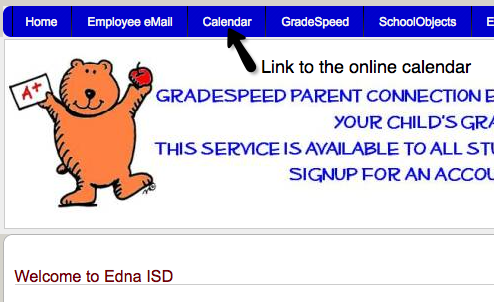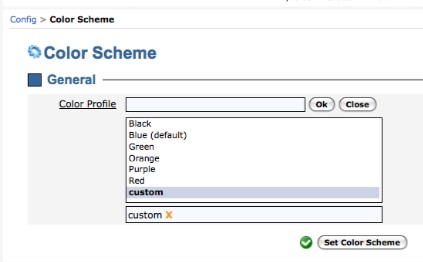 Despite tough economic times, Congress has moved forward in recent times to implement programs that will expand the use of technology in education – from federal stimulus funds that can be applied toward upgrading technology resources in schools to the establishment of a new, federally funded national center focused on developing learning technologies.
Despite tough economic times, Congress has moved forward in recent times to implement programs that will expand the use of technology in education – from federal stimulus funds that can be applied toward upgrading technology resources in schools to the establishment of a new, federally funded national center focused on developing learning technologies.
American Recovery and Reinvestment Act of 2009
Also known as ARRA, the $787 billion federal stimulus package allocated $650 million for Educational Technology State Grants. The goals of the program are to:
(1) Improve student academic achievement through the use of technology in schools
(2) Assist all students in becoming technologically literate by the end of eighth grade
(3) Encourage the effective integration of technology with teacher training and curriculum development in order to identify successful research-based instructional methods.
Funds can be used for acquiring and maintaining hardware, software and connectivity equipment, professional development to enhance technology instruction, developing and implementing information technology education, application of technology resources to improve communication with parents, distance learning, and developing and using technology tools to enhance education.
The program was launched in the fall of 2009 and is expected to run through the 2012 fiscal year.
National Center for Research in Advanced Information and Digital Technologies
“It’s time that education had the equivalent of what the National Science Foundation does for science, Darpa does for the national defense and NIH [National Institute of Health] does for health,” – Lawrence K. Grossman
This new center within the U.S. Department of Education, was originally the 2001 brainchild of Lawrence K. Grossman, former president of NBC News and PBS and Newton N. Minow, the former chairman of the FCC. Nearly a decade later, Congress has finally allocated federal funds for the center, which will focus on awarding grants to organizations to research and develop learning technology. The current budget is $500,000 and the center will also solicit additional funds through private donations. The center is expected to begin awarding grants as early as fall 2010.
Links to article sources:
After 10 Years, Federal Money for Technology in Educatio The New York Times
Enhancing Education Through Technology Recovery Plan Recovery.gov
Image source:
Weebly: Website Creation Tool for Students
 While the digital era was founded on the ideal of universal access, the playing field isn’t always level. Even as access expands, technological skills can lag behind. As schools are discovering, today’s students often have an edge on their teachers, and gaps in technological expertise still remain.
While the digital era was founded on the ideal of universal access, the playing field isn’t always level. Even as access expands, technological skills can lag behind. As schools are discovering, today’s students often have an edge on their teachers, and gaps in technological expertise still remain.
The San Francisco-based website building service Weebly recently debuted a new teaching tool to help fill that gap. Established in 2006 and named to Time’s best website list in 2007, Weebly currently serves over 2 million users. Weebly for Education is the company’s version designed especially with students and teachers in mind.
The genius and beauty of Weebly is its simplicity. By providing a user-friendly website builder that utilizes a basic drag and drop interface, Weebly’s creators are helping to remove the barriers to all that technology offers. Cost is not an obstacle for Weebly users either since the basic service is free.
The school version enables entire classrooms to operate under a teacher account, with individual student passwords and user names and the option of limited or open access for privacy protection. A single basic teacher account can accommodate up to 4 classes of 40 students each at no charge. Premium subscriptions are available for a nominal additional charge (approximately $30 annually). This Weebly Pro upgrade includes customizable features, greater file upload capacity, and the ability to embed documents.
 Beyond affordability and ease of use, Weebly offers a multitude of professional looking free layouts and integrated tools for adding text, photos, and files. The education version includes an assignment feature that facilitates online homework submission. Students benefit from a platform for sharing content and a tool for creating unique portfolios. Besides posting lessons, teachers can add event calendars and newsletters, keeping busy parents informed of day-to-day school activities with the convenience of an online format.
Beyond affordability and ease of use, Weebly offers a multitude of professional looking free layouts and integrated tools for adding text, photos, and files. The education version includes an assignment feature that facilitates online homework submission. Students benefit from a platform for sharing content and a tool for creating unique portfolios. Besides posting lessons, teachers can add event calendars and newsletters, keeping busy parents informed of day-to-day school activities with the convenience of an online format.
Since Weebly’s school tool requires a minimal investment of time and money, there is no real risk in giving it a try. Ostensibly anyone with the most basic computer skills could have their own site up and running within an hour. Weebly tutorials available online provide step-by-step instructions if needed. An added incentive for adopting a web tool like Weebly is that it is in line with Green school initiatives to eliminate paper waste. At the same time it serves as a safe means to establish an online classroom presence at all grade and skill levels.
Wiki Creation Tools For Schools
 WikiSpaces is a Wiki creation site offering a free service that schools can utilize as well as a subscription service for educational systems that wish to have no advertising, unlimited users, and other features. The WikiSpaces site has an effortless sign up process followed by an easy initiation into creating a wiki in the form of several different video tutorials available on the site.
WikiSpaces is a Wiki creation site offering a free service that schools can utilize as well as a subscription service for educational systems that wish to have no advertising, unlimited users, and other features. The WikiSpaces site has an effortless sign up process followed by an easy initiation into creating a wiki in the form of several different video tutorials available on the site.
The editing features on WikiSpaces will be immediately familiar to any school student or school teacher who has used Microsoft Word to type a document as all of the basic commands used to format a wiki page are exceedingly similar in both presentation and design. Linking one wiki page on WikiSpaces to another is extremely simple and allows for quick and easy grouping of content which would be handy in a classroom setting when multiple pieces of content may be interconnected within a lesson plan or learning unit.
![]() PBWorks is a similar platform that can have a school or classroom set up with a “secure online workspace”. Students can immediately begin creating and editing content while the site creator can set customized security settings and create an overall theme for the specific wiki.
PBWorks is a similar platform that can have a school or classroom set up with a “secure online workspace”. Students can immediately begin creating and editing content while the site creator can set customized security settings and create an overall theme for the specific wiki.
PBWorks keeps a complete list of all edits and creations on a particular wiki which allows teachers or administrators to ensure all relevant material remains on site. The audit trail also ensures that anyone who does remove necessary content or adds unnecessary data to the wiki page can be identified and have their actions corrected.
Both WikiSpaces.com and PBWorks.com could be utilized in the classroom as a “class hub” where important assignments can be presented. When a special assignment is handed out, the wiki can become a virtual meeting place for related information and a catalog of handy sources that students can easily reference and access online. Since Wikis are editable by anyone with access to the Wiki, students and teachers can continue to add relevant material as it is gathered and catalog it with new wiki entries and pages.
As education continues to progress and cross into new frontiers, the ability to collaborate virtually is going to become more and more important. Wikis offer a easy and effective way to collaborate and share knowledge in an educational environment.
Top 10 Education Books of 2009
2009 was a solid year for educational releases, and the first year where many of the bestselling educational resources on Amazon.com were books for the Kindle. Here is a closer look at ten 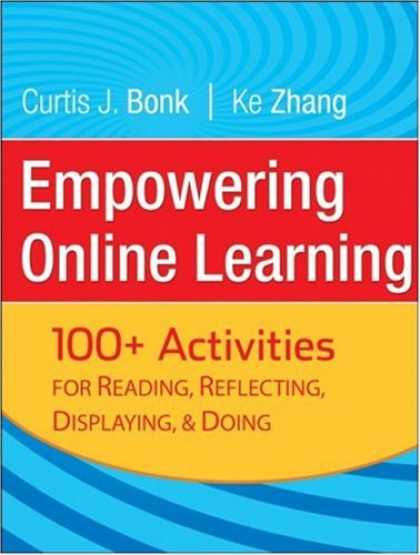 of the bestsellers on Amazon.com:
of the bestsellers on Amazon.com:
1. Empowering Online Learning: 100+Activities for Reading, Reflecting, Displaying, and Doing by Ke Zhang.
While this volume is catered towards exclusive online learning, the basic concepts it relays concerning content delivery online for different learning types can be utilized by educators who wish to supplement the classroom with digital content.
2. You Can Do It: How to Boost Your Child’s Achievement in School by Michael E. Bernard
You Can Do It is a parent’s resource first and foremost, but teachers can also benefit from a read. The book is particularly adept at offering advice on curtailing small problems before they become serious school performance issues.
3. Content Matters: A Disciplinary Literacy Approach to Improving Student Learning by Anthony M. Petrosky
This book outlines an instruction framework developed by the Institute for Learning at the University of Pittsburgh. It will prove a particularly good resource for teachers concerned with preparing junior high and high school students for a college education.
4. Wikiworld by Juha Suoranta and Tere Vaden
Wikiworld focuses on the course learning has taken in recent years with a particular emphasis on new types of critical learning and open collaboration (as in a wiki).
5. The Writing Teacher’s Lesson a Day: 180 Reproducible Prompts and Quick-Writes for the Secondary Classroom by Mary Ellen Ledbetter
Even the best teacher needs a little help sometimes, and this book provides the writing teacher with all of the prompts needed to keep high school students busy!
6. Building Online Learning Communities: Effective Strategies for the Virtual Classroom by Rena M. Palloff and Keith Pratt
The larger problems facing both educating and learning, especially within the context of modern education, are addressed in this book. It offers pointed advice for the crafting and utilization of engaging and educational online communities.
7. A Manual for Writers of Research Papers, Theses, and Dissertations, Seventh Edition: Chicago Style for Students and Researchers by Kate L. Turabian
Books to help students structure research papers and other school assignments are a must. This Kindle Edition of 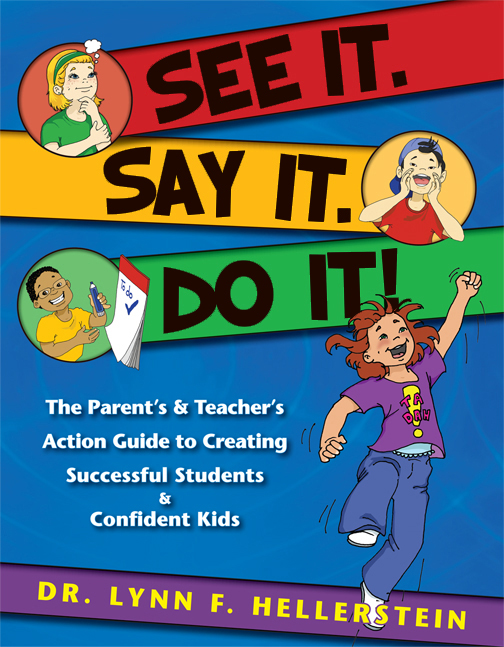 a classic resource was an educational bestseller.
a classic resource was an educational bestseller.
8. See It. Say It. Do It! The Parent’s & Teacher’s Action Guide to Creating Successful Students & Confident Kids by Dr. Lynn F. Hellerstein
This book’s main focus is on encouraging the use of visualization and imagery skills children already possess to help them, as students, grasp numerous types of learning challenges.
9. Teaching with Classroom Response Systems: Creating Active Learning Environments by Derek Bruff
This book emphasizes creative ways to use the “clicker” technology that is popular in colleges and universities. Beyond this basic premise though, the book is an effective idea board for interactive teaching.
The Classroom Teacher’s Survival Guide: Practical Strategies, Management Techniques and Reproducibles for New and Experienced Teachers by Ronald L. Partin
This new edition of “Teacher’s Survival Guide contains new information on inquiry-based learning and much more. It also features special web-access to additional supplemental materials for the teacher.
The ten best sellers featured here come from several different Educational subheadings. Many of the more popular books this year were Kindle editions, but a Kindle does not have to be owned to enjoy the books. Several feature hard copy versions and a PC version of the Kindle reader is available for free download for Kindle only books.
Technology Solutions Aim to Fill Education Gaps
Despite the nation’s commitment to the ideal of universal access to education, our  public schools frequently fall short of meeting the changing needs of students across the spectrum. The “no child left behind” mandate has still let some students slip through the cracks, revealing the structural deficiencies in our public school system. Schools struggle under budget constraints, and even the most dedicated teachers are only human. As it turns out, the one-size-fits-all approach is not the best fit when it comes to instruction since there isn’t just a single learning style that suits every student.
public schools frequently fall short of meeting the changing needs of students across the spectrum. The “no child left behind” mandate has still let some students slip through the cracks, revealing the structural deficiencies in our public school system. Schools struggle under budget constraints, and even the most dedicated teachers are only human. As it turns out, the one-size-fits-all approach is not the best fit when it comes to instruction since there isn’t just a single learning style that suits every student.
New entrepreneurial efforts are answering this need and seizing an opportunity to fill this educational gap with the latest in technology. They aim to provide educational solutions via technological avenues, offering software to supplement brick and mortar school instruction and even operating schools online. Technology offers the hope of bridging skill gaps by customizing instruction to target specific academic needs. And it helps fill the gap in science and math at the teaching level since instructors often lack experiential background in these subjects.
A major force in this new wave of online instruction is Ron Packard, CEO of K12. Inspired by his own futile search for a complete online course to help a daughter struggling with math, Packard devised a business model for a full-fledged web-based school. K12 now provides over 20,000 hours of instructional content covering the full K-12 progression (see story in Forbes). Operating its own web-based school as well as furnishing support to other online schools, K12 serves 70,000 pupils and generates $400 million in revenue.
While K12’s students aren’t a representative sample of the public school population, they all have needs which public schools failed to satisfy. They are students with exceptional talents as well as exceptional needs. Online schools cater to scholar athletes and others who find conventional school schedules conflict with extracurricular passions. In some cases, parents turn to online instruction because they see their own values in conflict with those represented by public school instruction.
Apex Learning is another entrant in this growing field. In operation since 1997, Apex Learning targets poor academic performers who are at risk of becoming part of a growing statistic, the million annual high school drop-outs. In addition to distance instruction courses, Apex Learning markets its programs to public schools, enabling more individualized, computer-focused learning in a regular classroom setting.
Making inroads into the achievement gap, Revolution Prep offers software that helps pinpoint and address concept/skill deficiencies. Its program has been adopted by Los Angeles schools to help struggling high school students pass mandated exit tests.
Confronting the challenges and limitations in our present public school system, technology is helping transform the role of teacher from lecturer to facilitator, and easing the workload on instructors at the same time. Technology provides a workable means of identifying and serving the unique academic needs of diverse students, while freeing teachers from some of the burden of devising and implementing lesson plans, and even filling the gap in subject expertise.
The idea of standardized online curriculum in public schools may strike some as revolutionary. But as weaknesses in the well-intentioned educational policies of the past grow more apparent, the concept seems tailor-made for the future of digital technologies in schools.
With most of the US currently experiencing the coldest  temperatures in recent years, Intand’s Tandem event management software can be an effective tool for schools to stay ahead of the curve and “winterize” when the weather turns bad.
temperatures in recent years, Intand’s Tandem event management software can be an effective tool for schools to stay ahead of the curve and “winterize” when the weather turns bad.
To close or not to close? School administrators have to consider many factors – from the weather report to building conditions and transportation resources when making the decision to close or delay school openings due to weather conditions. Tandem can assist in the decision making process by providing an overview of what programs and events will be affected.
Communicate closings and school delays quickly. No more waiting for the local radio or television station to announce your school’s name. By using Tandem administrators can instantly alert parents, students and teachers when school opening is delayed or canceled.
Keep students from being stranded in the cold. After school activity canceled due to weather? Early school closing? Buses delayed? Using Tandem, administrators, teachers and coaches can alert parents quickly, helping to ensure that students stay warm and safe.
Avoid burst pipes and other weather calamities. Using Tandem to identify building and room usage, facilities manager can efficiently plan and direct resources to avoid burst pipes and other potential weather calamities that can be costly and time consuming. In addition, faculty and facilities staff can quickly alert involved stakeholders when there is a problem – so that room changes and adjustments can be made with minimal disruption.
Transportation management. Bad weather often translates to last minute transportation changes and juggling. Tandem allows all stakeholders to communicate rapidly and coordinate transportation resources more effectively so that bad weather doesn’t have to translate into a costly, transportation nightmare.
Avoid influenza and H1N1 outbreaks. Winter usually brings flu season. By utilizing Tandem administrators can keep families informed of community or school resources for vaccination and work together to avoid outbreaks.
Image source http://www.flickr.com/photos/laserstars/
 Want to learn more? Sign up for a free demo or a 30 day free trial of Tandem for Schools.
Want to learn more? Sign up for a free demo or a 30 day free trial of Tandem for Schools.
At a recent conference on Breakthrough Learning  in the Digital Age, Google co-founder Sergey Brin addressed the increasingly prominent role of technology in schools. Paradoxically a high-school drop-out himself, Brin is part of the search engine monolith’s mission to advance the ideal of universal computer access. Stepping up its involvement in the educational arena, Google has lately supplied schools with its top apps at no charge. But the technology giant’s agenda isn’t all altruism. Google’s growing interest and generosity serve a dual purpose, arming the next generation with the latest tools for success while weaning them on Google’s own brand, thus ensuring a pipeline of future consumers already conversant in the language of the company’s product line.
in the Digital Age, Google co-founder Sergey Brin addressed the increasingly prominent role of technology in schools. Paradoxically a high-school drop-out himself, Brin is part of the search engine monolith’s mission to advance the ideal of universal computer access. Stepping up its involvement in the educational arena, Google has lately supplied schools with its top apps at no charge. But the technology giant’s agenda isn’t all altruism. Google’s growing interest and generosity serve a dual purpose, arming the next generation with the latest tools for success while weaning them on Google’s own brand, thus ensuring a pipeline of future consumers already conversant in the language of the company’s product line.
Brin expressed his conviction that today’s curriculum needs to reflect technology’s expanded role, suggesting that the subject of computer science be given a slot alongside math and English in schools. He promoted the idea of textbook downloads and proposed that students be utilized as tech tutors for younger kids as well as seniors. Students, he suggested, could polish their writing skills as Wikipedia contributors. And Brin was adamant that we could not afford to neglect teachers, insisting that our educators need to be better rewarded.
The proliferation of broadband and the increasing affordability of computer equipment are putting technology within reach of greater numbers with each passing day. Yet even as he foresees a future approaching that ideal of universal access, Brin perceives a downside for students in this digital age, recognizing that expanding horizons can be a humbling, ego-deflating experience. Gaining a global perspective can make one’s own talents seem puny by comparison.
Critics might argue that technology and its availability alone are not the answer to what ails the educational system. Putting laptops in the hands of every student is not enough without the input of dedicated teachers, involved parents, and supportive communities. Children are already wired by nature to learn. Sometimes we just need to get out of the way and remove the barriers to learning.
Providing students with the right tools only makes sense. If Google and its counterparts in the tech sector are eager to help underwrite that effort, our financially strapped schools are sure to welcome the support. However, there needs to be a caveat. Not that long ago, schools across the nation were reconsidering having jumped at the chance to earn a few perks by allowing the big soda companies to stock their products in cafeteria vending machines. Whether by coincidence or consequence, a wave of childhood obesity followed. As we usher in the digital age with the support of giants like Google, schools should take care not to sell out the malleable minds in their charge.
Image source http://www.flickr.com/photos/dannysullivan/ / CC BY 2.0
BioInteractive,  is a free online interactive website created by Howard Hughes Medical Institute (HHMI), one of the leading non-profit medical research organizations in the US. The free award-winning website provides students and teachers with access to fully interactive laboratory modules that allow students to virtually conduct biomedical experiments. HHMI’s web-based collection of online teaching tools and materials encourage students to learn about biology with with free access to podcasts of HHMI researchers’ lectures, animations of biology topics, and other free learning materials. Through the site’s “Ask a Scientist” portal, students can also submit questions on everything from anatomy to DNA.
is a free online interactive website created by Howard Hughes Medical Institute (HHMI), one of the leading non-profit medical research organizations in the US. The free award-winning website provides students and teachers with access to fully interactive laboratory modules that allow students to virtually conduct biomedical experiments. HHMI’s web-based collection of online teaching tools and materials encourage students to learn about biology with with free access to podcasts of HHMI researchers’ lectures, animations of biology topics, and other free learning materials. Through the site’s “Ask a Scientist” portal, students can also submit questions on everything from anatomy to DNA.
Laboratory modules include a bacterial identification lab, a cardiology lab, a neurophysiology lab and a virtual ELISA (Enzyme-Linked Immunosorbent Assay) using human antibodies to diagnose disease. Each module starts with a laboratory intro that provides a detailed overview of the experiment topic.
Using the laboratory notebook and following instructions, students are lead step-by-step through the process of conducting an experiment by clicking on online laboratory equipment. Detailed links and explanations throughout the lab, allow students to understand both the how and why of each step. A glossary section allows students to learn and understand important terms.
Teachers and schools can also order free DVD copies of the site’s videos, animation and lecture podcasts on a wide range of biology topics, including the science of fat, stem cell development and regeneration, and genes and gender.
How iTunes University Changes Education
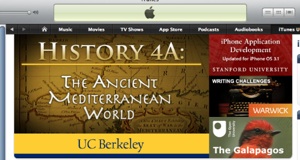 iTunes University is a diverse collection of easily accessible and free podcasts, videos, and TV shows uploaded into the iTunes library from colleges, universities, and other educational organizations. Any student, teacher, or parent with the free iTunes software downloaded into their computer can access this content. If you have a iPod you can download these podcasts and carry a world of knowledge around in your pocket.
iTunes University is a diverse collection of easily accessible and free podcasts, videos, and TV shows uploaded into the iTunes library from colleges, universities, and other educational organizations. Any student, teacher, or parent with the free iTunes software downloaded into their computer can access this content. If you have a iPod you can download these podcasts and carry a world of knowledge around in your pocket.
The iTunes University homepage is accessed from the iTunes software. The iTunesU icon will appear in the left hand column of the software and include a number list of downloaded materials. When this icon is clicked the main iTunes University page is brought up containing featured courses and educational institutions that rotate in the top bar. Noteworthy contributions are also featured in the lower half of the screen. An iTunes U Quick Links section breaks down the “university” into four links: Universities & Colleges, Beyond Campus, K-12, and iTunes U Power Search.
The K-12 section of the site contains contributions from several state educational systems as well as selections targeted specifically towards educators. Eager teachers and schools that already have started an online library of video content can also apply to have their content features in iTunes U where it can be accessed by students and schools all over the world.
The opportunities for a real virtual classroom are game-changing when coupled with the power of the iTunes distribution. Any content contributed will be archived for use in subsequent school years making this service a valid consideration when planning to incorporate more technology into school. A one time investment of time can provide years of learning supplementation, especially in courses such as math where information remains relatively static. Tools like iTunes University allow teachers to create content that can be shared with students all over the world. This allows students the opportunity to tap the collective knowledge of a vast number of teachers, which was not possible for students just a few years ago. Students who live in areas with limited teaching resources now have the opportunity access to great teaching for free.
Past the secondary school level on iTunes U is the rich library of content from colleges and universities. These videos and podcasts can be utilized by high school teachers in a number of ways. Videos that cover an element of a current classroom project can be incorporated into lesson plans and viewed during class or assigned as extra credit. Students who need to do research for a paper or school fair can also access the library and view videos from prestigious universities like Yale for a multimedia source on an assigned topic.
Integrating Tandem’s online calendar with your already existing school website is simple and easy, requiring very little technical knowledge. Since a Tandem school calendar is a hosted service (or software as a service, SaaS), there is no software to install or major changes required to your existing website. When you sign up for a Tandem school calendar you will be given a specific URL such as http://Lakewood.Tandem.com. Simply add a link from your school website to your Tandem school calendar’s specific URL. You can request that the webmaster of the school website add this link, or you can add it yourself if you know how.
Once you have linked to your Tandem calendar, visitors to your school website can easily access the school’s online calendar by clicking on the link or they can type in the URL in their web browser.
Customizing Your Online School Calendar
Tandem allows you to easily change the color scheme of your school calendar. Currently the available colors are blue, black, green, orange, purple, and red. You can also add your school logo to your calendar by uploading the image. Both of these customizations can be easily made in the “Config” menu so there is no programming required.
